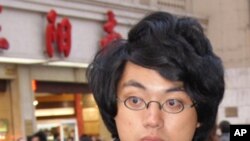Chou Davy is a young French-Cambodian filmmaker, whose grandfather, Van Chann, made movies in Cambodia in the 1960s and 1970s.
Following in his grandfather’s footsteps, Chou Davy has now had his first feature-length documentary shown at an international festival in Busan, Korea.
Chou Davy’s parents fled to France in 1973, and the young man returned to Cambodia for the first time in 2009.
He stayed for almost a year, training Cambodian students to produce movies, one of which, “Twin Diamond,” screened at the Lux Cinema in Phnom Penh. He also organized a film exhibition called “The Golden Reawakening,” in the capital, before returning to France for a short time.
The following year, he returned with a film crew. For a month, the team shot a documentary, “The Golden Slumbers,” which was screened at the Busan International Film Festival last week.
“It’s a very big honor for me because it’s said to be the biggest film festival in all Asia,” he told VOA Khmer in a recent interview. “I am so pleased, because it is my very first feature film and have this chance, that this film is selected to this very important festival. Also I’m very proud that Cambodia is represented there because it’s introduced there in Busan as a Cambodian film.”
The film chronicles the “Golden Age” of Cambodian cinema, which began in the 1960s but was extinguished when the Khmer Rouge took power, in 1975. The story of that period is told through the recollections of three film directors—Ly Bun Yim, Yvon Hem and Liv Sreng—and one of the period’s famed actresses, Dy Saveth.
“The film is not only the testimonial interviews of the survivors,” Chou Davy said, “but is also dealing with the present of Cambodian cinema. What has become of the cinemas that have been shut down and now transformed into different places, such as karaoke [clubs] and restaurants?”
As he researched the film, Chou Davy learned how the directors and actress survived the Khmer Rouge and how they moved on after many hardships. The film represents the first time their stories have been told.
“Those stories of their lives and all the regret and everything, some of them didn’t express those feeling for a very long time,” Chou Davy said. “So that was also something very moving for me and very strong.”
More than 400 films were produced during Cambodian cinema’s halcyon days. Only 35 survived. In his search, Chou Davy found that many of the films had survived in the memories of their former producers and stars, and in the memories of those who had watched them. On the street, he would look for Cambodians of a certain age, in their fifties or sixties, and he would ask them if they had watched films before the Khmer Rouge.
“All of them would start to tell me the stories that they really loved, telling me the story from A to Z,” Chou Davy said. “And it was like the film was just shown the day before, even if they hadn’t seen it for 40 years. That was something very strong and very magic, that the cinema brought so much joy to the people that they could never forget.”




